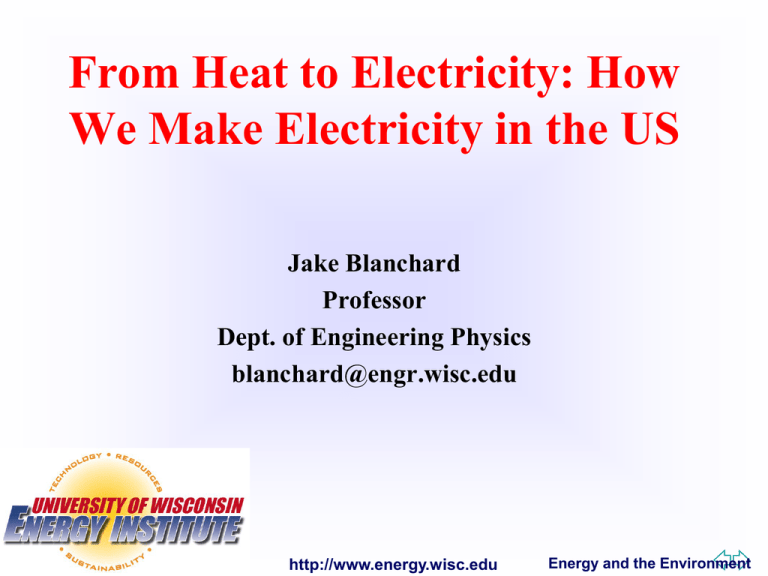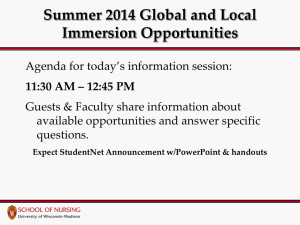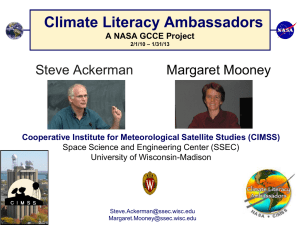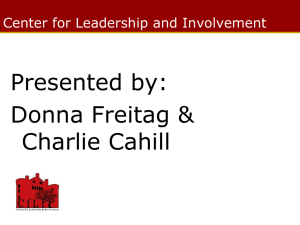Energy and the Environment
advertisement

From Heat to Electricity: How We Make Electricity in the US Jake Blanchard Professor Dept. of Engineering Physics blanchard@engr.wisc.edu http://www.energy.wisc.edu Energy and the Environment Outline How much energy do we use? What is the difference between energy and power? How do we make electricity? How much does it cost? http://www.energy.wisc.edu Energy and the Environment Energy Usage History (Sci.Am. 1970) Michael Phelps eats 12,000 kcals/d 1 apple ~ 100 kcals Sources: EIA, International Energy Outlook 2000 US Bureau of the Census, International Database http://www.energy.wisc.edu Energy and the Environment Energy Usage History Energy in world history By Vaclav Smil 164 (1000 kcal/d) http://www.energy.wisc.edu Energy and the Environment Energy Units/Measures 1 Joule – metric unit of energy Approximately the energy needed to lift an apple 1 meter Kilocalorie=4,184 Joules So eating an apple provides 100 kcals or 418,000 Joules 1 Btu = 0.25 kcals=1,055 J So eating an apple provides about 400 Btu 1 kW-hr=1 kW consumed for 1 hour = 3.6 MJ = 3413 Btu http://www.energy.wisc.edu Energy and the Environment Some Useful Facts 1quad equals 1 quadrillion Btu (1015 Btu) The US uses about 100 quads per year A 1 GWe coal plant produces about 0.03 quads each year http://www.energy.wisc.edu Energy and the Environment An Example To heat a typical home for a year: 100 Million Btu 6,000 pounds of coal 8,300 pounds of dry wood 86,000 cubic feet of natural gas 1 gram of uranium 800 gallons gasoline Depends on climate, construction, size of home http://www.energy.wisc.edu Energy and the Environment Power vs. Energy Power is a measure of the rate at which we consume energy It takes about 100 Btu to heat 1 pound of water by 100 degrees F To do this in 1 hour takes a power of 100 Btu/hr or 0.03 kW=30 W To do this in 6 minutes, takes 1,000 Btu/hr or 0.3 kW So more power provides the same amount of energy, but in a shorter time http://www.energy.wisc.edu Energy and the Environment Power Units 1 Watt=1J/s 1 kW=1000 Watts 1 Btu/hr=0.29 Watts 1 horsepower=2,544 Btu/hr=746 Watts http://www.energy.wisc.edu Energy and the Environment Examples A typical refrigerator uses 700 W A typical air conditioner uses about 1100 W http://www.energy.wisc.edu Energy and the Environment Creating Electricity – What is it? Electricity is just electrons flowing in a wire We need to take a fuel, burn it, and use it to push electrons out to customers http://www.energy.wisc.edu Energy and the Environment Converting Heat to Electricity The key is the generator Turn a coil in a magnetic field This produces electricity http://www.energy.wisc.edu Energy and the Environment Some Useful Terms The number of electrons pushed through the circuit is the current – measured in amps The “pressure” that pushes these electrons through the circuit is the voltage – measured in volts http://www.energy.wisc.edu Energy and the Environment AC vs. DC AC=alternating current DC=direct current In DC, the current always flows in one direction In AC, the current flows back and forth It changes direction 60 times per second (60 Hz) http://www.energy.wisc.edu Energy and the Environment Why AC? We use AC because it is easy to change the voltage of an AC signal and we lose less power if we transmit electricity at high voltage So we Create electricity at low voltage Step it up for transmission (1 Million Volts) Step it down for distribution (1,000 Volts) Step it down before it gets to our home (120 V) http://www.energy.wisc.edu Energy and the Environment How does a generator make AC? http://www.energy.wisc.edu Energy and the Environment How do we change the voltage? http://www.energy.wisc.edu Energy and the Environment What turns the generator? Start with high temperature, high pressure steam Blow it over turbine Steam turns turbine and turbine turns generator http://www.energy.wisc.edu Energy and the Environment The turbine/generator system http://www.energy.wisc.edu Energy and the Environment The Entire System http://www.energy.wisc.edu Energy and the Environment Gas Turbines are Similar http://www.energy.wisc.edu Energy and the Environment Efficiency We cannot convert all of the energy in a fuel to electricity We lose quite a bit of energy A typical steam plant converts energy to electricity at about 33% - We lose 2/3 of our energy That is, the conversion efficiency is about 33% A typical car (internal combustion) has an efficiency of about 20% http://www.energy.wisc.edu Energy and the Environment Efficiency http://www.energy.wisc.edu Energy and the Environment Electricity Usage in U.S. for 2010 (Quads) http://www.energy.wisc.edu Energy and the Environment Electrical Energy Conversion Theoretical Efficiency of Energy Conversion Devices Convert Potential Energy (hydro) ~ 100% (75-90%) Electrochemical cell (fuel cell) ~ 100% (20-40%) Heat Engine (rankine cycle) ~ 66% (30-50%) Solar Cells (photovoltaic) ~ 20% (10-20%) Thermionic ~ 10% (<<10%) Thermoelectric ~ 10% (<<10%) http://www.energy.wisc.edu Energy and the Environment Our Options Coal, natural gas, oil burn these fossil fuels Boil water and send to turbine Nuclear Split uranium to make heat Hydro, Wind Flowing water or wind turns the turbine Solar Use silicon to directly convert heat to electricity Use heat to heat home or water Use heat to boil water http://www.energy.wisc.edu Energy and the Environment http://www.energy.wisc.edu Energy and the Environment What is the current situation in US? U.S. Energy Usage Coal 23% http://www.energy.wisc.edu Energy and the Environment http://www.energy.wisc.edu Energy and the Environment Wisconsin: Renewables Share WI 2010 Renewables: 7.2% 0.1% Biomass 0.7% 1.4% Wood 1.7% Wind 3.3% Hydro Source: Wisconsin Energy Statistics 2009 (Consumption) 1 Btu = 1.055 kJ http://www.energy.wisc.edu Energy and the Environment Cost of Electricity http://www.energy.wisc.edu Energy and the Environment http://www.energy.wisc.edu Energy and the Environment Summary Energy and Power are different, but related Different fuels have different energy contents The conversion process is inefficient Most current electricity is produced using steam or gas turbines http://www.energy.wisc.edu Energy and the Environment










